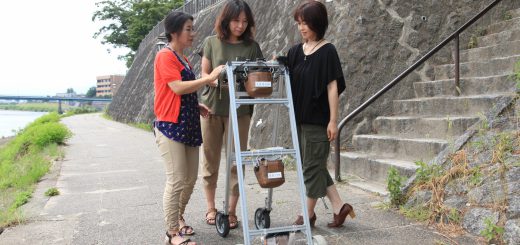The Hydrogen Explosion in Fukushima Daiichi Unit 1 Nuclear Reactor Building Occurred on the 4th Floor, Not the 5th! Nuke Info Tokyo No. 157
Science journalist and former member of the National Diet of Japan Fukushima Nuclear
Accident Independent Investigation Commission (NAIIC)
On August 27 of this year, I sent a letter of request titled “Regarding continuation of the investigation into causes of the accident at the Fukushima Daiichi Nuclear Power Station of the Tokyo Electric Power Company, and execution of the on-site inspection by the Diet centered on the 4th floor of the Unit 1 reactor building (request)” by fax and mail to Bunmei Ibuki, Speaker of the House of Representatives, and Masaaki Yamazaki, Chair of the House of Councillors. In addition, I held a press conference at the Diet Office Building with attorney Yoshinori Ito, who had, as a cooperative member of NAIIC, worked with me for half a year in the same NAIIC working group.
In fact, on February 7 of this year, Mr. Ito and I sent letters to the then speakers of both houses, requesting the Diet to conduct the on-site investigation of the 4th floor of the Unit 1 reactor building of Fukushima Daiichi Nuclear Power Station (FDNPS). This was because we knew that TEPCO had stonewalled the very investigation NAIIC was planning to perform.
However, even though we have requested an on-site inspection of the 4th floor of the Unit 1 building twice within a half year, there has been no response from the Diet, nor has the inspection been conducted.
One year has already passed since the Diet’s investigation into the accident was dissolved, but there is now more reason than ever, of course, for our sticking to the 4th floor of the Unit 1 building. It appears there is a possibility that the prolonged violent seismic motion due to the earthquake (March 11, 2011) damaged the emergency isolation condenser (IC) pipes located in the 4th floor, causing a small-break LOCA (loss-of-coolant accident). The issues we are being particular about are not limited to that, however. There is one more major item. That is the matter of whether or not it was really the tsunami that caused the so-called “Station Blackout” (SBO: loss of all AC power to a nuclear plant). In fact, the results of the most recent detailed investigation and analysis by Mr. Ito into Unit 1, in particular, lend strong credence to arguments that the cause of the SBO was “something else,” and not the tsunami.
The September issue of the monthly Science Journal Kagaku (Iwanami Shoten, Publishers), released on August 26, carried Mr. Ito’s disquisition on the connection between the tsunami and SBO(1), and my own disquisition(2) on the 4th floor of the Unit 1 building. These two disquisitions constitute “our current thoughts” on the above-mentioned unresolved issues. On the basis of these two disquisitions, as stated above, on the next day (August 27), we made a request to the speakers of both houses for an on-site inspection of the 4th floor of the Unit 1 building as a continuation of the NAIIC investigation.
In an explanation and discussion of the SBO problem by Mr. Ito himself, broadcast live over the Internet by CNIC, he gave the view that the SBO at “Fukushima Daiichi Nuclear Power Station Unit 1 was not caused by the tsunami.”(3) Due to limited space, I cannot include the details here, but regarding the above-mentioned “something else,” a former GE nuclear engineer by the name of Satoshi Sato has an interesting hypothesis, in relation to which, important questions are posed regarding the new regulatory requirements.
Thus, in order to reflect the latest dispute regarding the tsunami and SBO, I will present my own hypothesis below on what occurred on the 4th floor or the Unit 1 building.(4)
Water Leakage Phenomena and the Possibility of an SR Valve Non-function
The NAIIC report(5) does not mention the possibility that the IC pipes may have broken due to seismic motion or that a loss-of-coolant accident (LOCA) may have occurred. Personally, however, during the NAIIC investigation, I was thinking that there had been a small-break LOCA with small cracks developing in the piping directly connected to the IC units on the 4th floor of the reactor building due to the prolonged violent seismic motion, which continued for several minutes, causing reactor coolant to shoot out from them (and basically, my thoughts on this have not changed). In fact, there were at least two events at the scene that would lead one to think that way.
The first is that “water leakage phenomena,” with water suddenly gushing out from somewhere, did occur right after the earthquake on the 4th floor of the Unit 1 building, where the IC units were located. This leakage was witnessed by several employees who happened to be working on the 4th floor at that time.
The second is that there is no evidence whatsoever that the main steam release safety valves (SR valves) functioned—i.e., it is possible that they didn’t work at all. An SR valve is a device for reducing pressure in a nuclear reactor by releasing steam, automatically or by manual operation, from within the reactor to the outside, but particularly in the case of the Mark I type containment vessel used in FDNPS Units 1 to 5, which has a doughnut-shaped pressure suppression chamber, when an SR valve operates, “hydraulic dynamic loading,” a large dynamic force, is known to occur in the pressure suppression chamber, and I imagine that it would produce a violent vibratory noise in the chamber. In fact, in Units 2 and 3, SR valves began functioning frequently about ten minutes after the earthquake, and when they did, it sounded like the earth rumbling, audible as far away as the Central Control Room, as was learned from the testimony of several operators.
We also learned from a questionnaire survey conducted by the NAIIC that noise from the operation of SR valves could be heard at Onagawa NPS Units 1 and 3, which have an improved version of the same Mark I containment model (Unit 2 was off-line for periodic inspections).
In the case of FDNPS Unit 1, however, we learned from interview surveys with the workers during the NAIIC investigation that not one person among the workers heard the sound that an operating SR valve would have made. In the case of Unit 1, SR valves would normally have been operating repeatedly right after a tsunami, but nobody heard the sound that would have accompanied them. The hypothesis that perhaps by chance they couldn’t hear them because they were drowned out by other noise nearby does not stand up to scrutiny. The plant suffered a complete loss of electrical power after the tsunami hit, and the workers testified that Unit 1 was engulfed in darkness and silence.
If any of the SR valves of Unit 1 were not functioning, it indicates that one pipe or another into or from the reactor (e.g., an IC pipe) had been damaged by the earthquake jolts, and the coolant leaking from it reduced the pressure so that the pressure inside the reactor never rose as high as would be expected, and one could surmise that as a result the SR valves did not function.
The water leakage phenomena and possible non-functioning, or lack of necessity to function, of the SR valves by themselves, however, do not provide enough evidence to lead inevitably to the conclusion that a small-break LOCA might have occurred in the IC pipes due to seismic motion. More direct evidence or further proof is needed to draw such a conclusion.
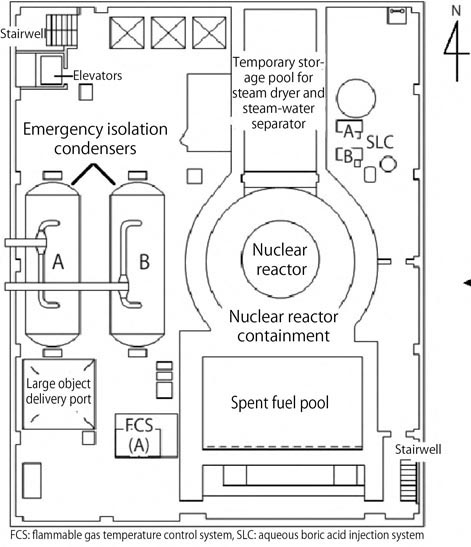 |
 |
| Fig. 1 Fourth floor plan of Fukushima Daiichi NPP Unit 1 reactor building (prepared by the Citizens’ Nuclear Information Center, based on figures appearing on TEPCO’s website). | Fig. 2 East-west elevation plan of Fukushima Daiichi NPP Unit 1 reactor building (prepared by the Citizens’ Nuclear Information Center, based on figures in documents for application for permission to make changes in the arrangement of the nuclear reactor) |
The Missing Heavy Steel Cover of the Equipment Hatch Provides Evidence that the Hydrogen Explosion at Unit 1 Occurred on the 4th Floor
Late last year I became aware that further proof of a small-break LOCA in the IC pipes had been found. During the NAIIC investigation, and after it was dissolved, I happened to see on my computer numerous times the motion videos taken by cameras surveying the interior of the 4th floor of the reactor building (videos that had all been shot by TEPCO and released on TEPCO’s website), and that provide the evidence.(6)
TEPCO investigated the 4th floor of the Unit 1 building several times, and each time they recorded scenes of violent destruction of the 4th floor interior in their survey videos (Photos 1 and 2). TEPCO gave the following explanation on what could have caused such violent destruction in its final report published in May of last year.(7)
On the fourth floor of the R/B where the IC main unit is installed, there was a hole on the north ceiling due to the hydrogen explosion on the fifth floor, and removed insulation and debris were scattered on the north side of the top portion of the IC thought to be caused by the explosion’s blast. The insulation on the south side of the IC was severely torn and removed on the R/B equipment hatch side (opening). It is considered that the hydrogen explosion on the fifth floor blasted through the opening and damaged the insulation on the IC. No insulation on the third or second floor was removed or scattered.(author’s italics)
In other words, TEPCO’s conclusion is that all of the violent destruction of the 4th floor interior was caused by the blast from the hydrogen explosion on the 5th floor.
For example, the explanation in the excerpt above says, “The insulation on the south side of the IC was severely torn …” Indeed, Photo 1 shows the metal cover and insulation on the IC units (cylindrical tanks) had been violently stripped off. TEPCO adds the explanation that this occurred because of the blast from the hydrogen explosion on the 5th floor passing through the opening (equipment hatch). Such a case, however, would have been impossible, as explained below.
The opening described in the explanation is a square-shaped hatch with sides of about 5 meters each on the floor of the 5th storey (i.e., the 4th storey ceiling). This hatch is used when delivering large pieces of equipment or materials, so it is often simply called an “equipment hatch,” but when it is not in use, it is covered with a steel lid (weighing about 1.5 tons), as shown in Photo 3, to prevent falls. Also, during the NAIIC investigation, we confirmed that the equipment hatch had been in use shortly prior to the earthquake, but had been closed, according to veteran workers, after the delivery operations had finished, just a little before the earthquake.
In other words, at about 2:30 p.m. on March 11, 2011, the equipment hatch was closed. From then on until after 3:30 p.m. on March 12, when the hydrogen explosion occurred, the hatch should have remained shut, so inasmuch as the steel hatch was not blasted downward into the 4th floor from an explosion on the 5th floor, there should not have been any blast coming through the equipment hatch and tearing insulation off the IC units on the 4th floor, and judging from the lack of any hatch being discovered on the 4th floor, it can be said that nothing of the sort happened.
On the other hand, as Photo 4 shows, it is an uncontestable fact that the steel lid of the equipment hatch has completely vanished. So, where did the hatch go and how did it vanish?
This mystery is solved easily if we say the explosion occurred on the 4th floor and not on the 5th, as TEPCO and many specialists are saying. If the hydrogen explosion occurred on the 4th floor, it would have raised the lid from below and the violent blast would have blown it away, consequently falling somewhere on the 5th floor or may even have been sent flying outside from the 5th floor.
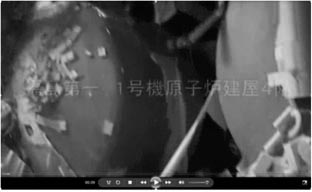 |
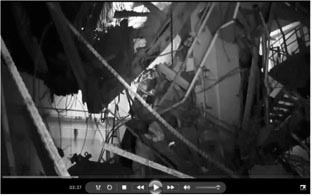 |
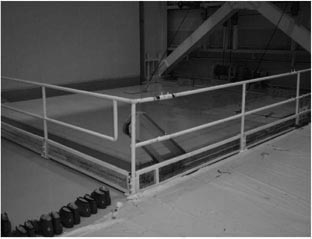 |
| Photo 1: The two IC units (4th fl., Unit 1 bldg.) | Photo 2: Immense destruction on the 4th floor of the Unit 1 building. | Photo 3: The steel lid of the equipment hatch on the 5th floor of the Unit 1 building. |
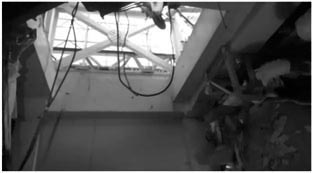 |
| Photo 4: Looking up from the 4th floor to the equipment hatch (the steel lid blown away by the hydrogen explosion is missing, an IC unit is visible to the right). |
Was the Source of the Hydrogen on the 4th Floor from the IC Pipes?
But why then did a hydrogen explosion occur on the 4th floor? What would the supply route of hydrogen to the 4th floor have been?
It doesn’t take long to find an answer to this. The hydrogen would have originated from a reaction between water and zirconium in the damaged nuclear fuel rods inside the reactor pressure vessel. The hydrogen thus generated would have entered the IC steam pipes and led by them ultimately to the 4th floor of the nuclear reactor building. Therefore, if the IC steam pipes or the drain pipes beyond them (steam condenser pipes) had been damaged by the seismic motion, the hydrogen would have been leaking from them continuously inside the 4th floor.
The water-zirconium reaction occurs at above 900°C, so the hydrogen reaching the 4th floor of the reactor building would probably have been at about that temperature. The 4th floor, where the two IC units were located could be said to be a sealed space, so if hydrogen at more than 900°C was gradually building up in that space, in the course of time it would have resulted in a large-scale hydrogen explosion through spontaneous combustion.
Regarding a 5th Floor Hydrogen Explosion
I must add that I am not asserting that no hydrogen explosion at all occurred on the reactor building 5th floor. It would be natural to think that perhaps a hydrogen explosion also occurred on the 5th floor. The reason is because the hydrogen generated in the reactor pressure vessel, as many experts have pointed out, is thought to have leaked into the 5th floor from the flange joint on the top lid of the containment vessel. Then, by the time the hydrogen explosion occurred on the 4th floor it is thought that quite a large volume of hydrogen would have accumulated on the 5th floor as well.
The walls of the 5th floor of the Unit 1 building, however, were not made of thick steel-reinforced concrete like the other floors, but with simple panels stuck onto a steel frame structure, so the 5th floor would have been affected by the cold atmospheric temperatures outside along the coast in March, and it is inferred that the temperature inside was not very high. If that is the case, there would have been no spontaneous combustion of the sequestered hydrogen. If a hydrogen explosion occurred on the 4th floor, however, due to spontaneous combustion, it would have blown the hatch off from the large object delivery port on the 5th floor, and it is thought that the hot blast violently entering the 5th floor would have instantaneously caused a hydrogen explosion on the 5th floor.
[Notes]
(1) Ito, Y. (2013) Total loss of AC power at the Fukushima NPP Unit 1 was not caused by the tsunami, Science Journal Kagaku, September 2013, pp.1045-1054.
(2) Tanaka, M. (2013) What does the violent destruction on the 4th floor of the Fukushima Daiichi NPP Unit 1 reactor building signify? –Questioning anew the possibility of an IC pipe rupture due to seismic motion, Science Journal Kagaku, September 2013, pp.1055-1066.
(3) CNIC-Ustream of Mr. Ito on the SBO: www.cnic.jp/movies/5385
(4) CNIC-Ustream related to this article: www.cnic.jp/movies/5373
(5) The Diet’s Report on the Investigation into the Accident can be read or downloaded at: warp.da.ndl.go.jp/info:ndljp/pid/3856371/naiic.go.jp/index.html
(6) photo.tepco.co.jp/date/201110-j/111021-02j.html
(7) ww.tepco.co.jp/nu/fukushima-np/interim/inex-j.html

